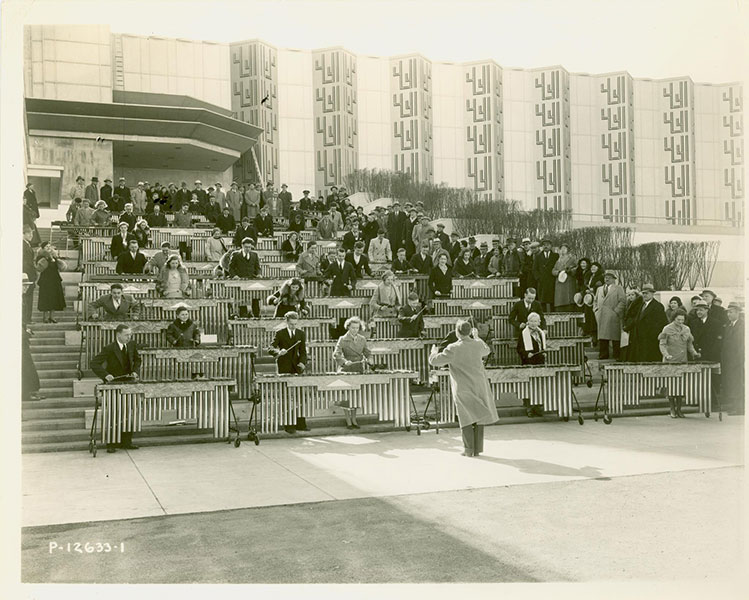Today’s post comes from our friends at Steve Weiss Music. Recently, Steve has began collecting some of the Deagan instruments that were used in the Marimba Orchestra. According to The Deagan Resource, there were a 103 marimbas and one xylophone built for the event.
Here’s were you can help! Steve is trying to put together a list of the 100 players who participated in the Marimba Orchestra. To best of our knowledge, this list is missing and we would like to help Steve collect this information. Please leave a comment below with any information you may have about the Marimba Orchestra.
Here’s the original post from Steve Weiss’s Website.
The 1933-1934 World’s Fair was held in Chicago and is known as ‘A Century of Progress International Exposition’. Clair Omar Musser organized a 100 piece Marimba Orchestra for the fair. Deagan produced 100 specially made marimbas for the performances, each marked with a plaque on the front with the player’s name and serial number. To be part of the orchestra, each player needed to purchase the instrument that they would perform on.
Steve Weiss has become very interested in the marimba orchestra, and has started to collect the original marimbas as well as any information regarding the performances. The names of all original player’s appears to have been lost by history. The goal of this project is to research and publish the names of all 100 original players for the benefit of the percussion community.
A Century of Progress Marimba Orchestra Members
Clair Omar Musser (Conductor and Soloist)
Jimmy (James) Namaro (Assistant Conductor)
Frank Bailey (Serial 44)
Lewis Wadsworth Gallagher (Serial 70)
George Hamilton Green
Leona Hubbard
Eddy Kozak
Lorraine Adeline Krause
Ruth Stuber Jeanne
Evelyn Marion Neal
Velma Arlene Sandt
Kathryn Schmitz
Russell Terry Simmons (Serial 4A)
Rudolph Robert Willmann (Serial 55)
Rose Mae Wise (Serial 73)
Chicago Tribune, Aug. 20, 1933
An unusual musical organization is now appearing nightly in the court of the Hall of Science. It is a marimba band of 100 pieces directed by Clair Omar Musser.
The marimba has an interesting history. Apparently it is one of the oldest musical instruments. There are records indicating it existed, naturally in a much cruder form, as long ago as 2000 B.C. In its modern form it becomes a tricky affair, a matter of careful workmanship, of tuning by mathematical devices that not only give the proper pitch to the fundamental tones but to their overtones, partials, harmonics as well.
The present band began its enrollment on Jan. 1, 1932. From the start it was planned as a feature of A Century of Progress, but not until now has it been able to appear in public. Several numbers have been specially composed for the organization, and all the others appear as special arrangements. Its membership is cosmopolitan to a high degree. One of the players, Kathryn Schmitz, comes from Berlin, Germany; another, Jimmy Namaro, is a native of London, England; George Hamilton Green comes from New York, Lorraine Adeline Krause from Washington, D.C.; Leona Hubbard from California. Some thirty other states are represented in the membership.
Chicago Tribune, Edward Moore, Aug 22, 1933
An uncommonly entertaining musical organization is playing nightly in the court of the Hall of Science at A Century of Progress this week. It is a marimba band of one hundred pieces directed by Clair Omar Musser, and in many ways it is the most interesting group of music makers that has so far had any connection with A Century of Progress.
The marimba is one of the oldest musical instruments of which there is a record. Yet, this battery of one hundred, with their graduated, glistening resonating pipes, is startlingly in accord with modern ideas of line and mass. Not only that, but that have what will be to most people unexpected resources as makers of music.
As the marimbas are played under Mr. Musser’s direction, the have inspiring rhythm, they are capable of almost anything in spacious harmonic chords, they make melody in all ways from the snappy staccato to long sustained curves of melody, the have a wide range of expression, and an equally wide range of tonal quality. In other words, they are capable of playing a program in a highly persuasive fashion.
In the Pilgrim’s chorus, for instance, out of Wagner’s “Tannhauser” overture they produce a tone which for sheer loveliness you will hardly hear surpassed anywhere. It is like a group of ideal French horns ideally played, in fact better played than any other orchestra or band is able to play them. Mr. Musser leaves off conducting once in the program to turn to his own marimba and play a solo part in Thomas’ “Mignon” orchestra. He is a virtuoso of the instrument, playing it as Horowitz plays the piano or Heifetz the violin.
Elsewhere you will hear some music specifically written for the group, Rosales’ Bolero for one, which is not Ravel’s famous work of the same name, but a good piece just the same, also an arrangement of a suite from “Carmen,” also made with the organization in mind. The concerts are drawing enormous crowds, just as always happens when something musically attractive goes on at A Century of Progress. They are confidently recommended.
- 3 Tambourine Strokes Every Percussionist Needs to Know - 03/07/2024
- Mihaly Csikszentmihalyi – Flow - 10/30/2021
- Percussion Education Reads 10/26/21 - 10/26/2021


